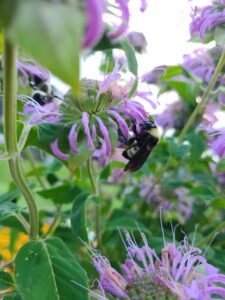Great Southeastern Pollinator Census
go.ncsu.edu/readext?951655
en Español / em Português
El inglés es el idioma de control de esta página. En la medida en que haya algún conflicto entre la traducción al inglés y la traducción, el inglés prevalece.
Al hacer clic en el enlace de traducción se activa un servicio de traducción gratuito para convertir la página al español. Al igual que con cualquier traducción por Internet, la conversión no es sensible al contexto y puede que no traduzca el texto en su significado original. NC State Extension no garantiza la exactitud del texto traducido. Por favor, tenga en cuenta que algunas aplicaciones y/o servicios pueden no funcionar como se espera cuando se traducen.
Português
Inglês é o idioma de controle desta página. Na medida que haja algum conflito entre o texto original em Inglês e a tradução, o Inglês prevalece.
Ao clicar no link de tradução, um serviço gratuito de tradução será ativado para converter a página para o Português. Como em qualquer tradução pela internet, a conversão não é sensivel ao contexto e pode não ocorrer a tradução para o significado orginal. O serviço de Extensão da Carolina do Norte (NC State Extension) não garante a exatidão do texto traduzido. Por favor, observe que algumas funções ou serviços podem não funcionar como esperado após a tradução.
English
English is the controlling language of this page. To the extent there is any conflict between the English text and the translation, English controls.
Clicking on the translation link activates a free translation service to convert the page to Spanish. As with any Internet translation, the conversion is not context-sensitive and may not translate the text to its original meaning. NC State Extension does not guarantee the accuracy of the translated text. Please note that some applications and/or services may not function as expected when translated.
Collapse ▲“Pollinators are under threat.” We hear it more and more from scientists and the news. If you haven’t heard, you’ve probably at least noticed that your windshield has stayed a lot cleaner over the last couple of decades. What is important to understand from this is that our survival as humans is linked with insect diversity and survival. How do scientists know insect populations are declining (besides the cleaner windshields)? They count them!
Now, scientists aren’t out there counting each and every one in an ecosystem. That is a Herculean task at least. At any given time there are about 10 quintillion (10,000,000,000,000,000,000) insects on Earth at any given time, according to the Entomological Society of America (ESA). More than 60 percent of the total species in the world are insects, with estimates speculating there are between 3-6 million species left to describe! Needless to say, that is a lot, and scientists need all the help they can get!
How can you help?
Queue the Great Southeast Pollinator Census! This simple community science project is an easy gateway for anyone interested in helping scientists. It is only two days each year. This year (2023) it is August 18 and 19.
All participants do is observe a plant that has pollinators visiting it for 15 minutes and tally each time an insect lands on the plant using the pre-designed datasheet (available for free download on the Census website). The datasheet has pictures of
what each insect is, so you don’t even have to know the names of the insects! Upload your counts to the GSEPC website afterwards using the QR code at the top of the page. That’s it!

Bombus pennsylvanicus American Bumblebee_Photo by Amanda Wilkins
You can do it anywhere where there is a plant with insects visiting it: your garden, a local park, a nature trail, or a botanical garden. You can take a Census on as many plants as you want within the two-day window.
Where can folks in Lee County do the Census together?
Folks in Lee County are in for a treat! There are so many places you can do the Census in Lee County! Besides your backyard, garden or woods, you can bring your datasheet and visit one of our local parks. Check out one of our local nurseries to see what is in flower! You can go observe at San-Lee Park’s Pollinator Garden or come to the Extension Office to observe in the Pollinator Haven Garden. The Extension Master Gardener volunteers of Lee County will be on hand at the Pollinator Haven Garden during two windows on August 18, from 9-11 a.m. and 2-4 p.m., and at the Sanford Farmers’ Market on August 19, 8:30 a.m. to 12 p.m. They will also be at the Pollinator Haven Garden on the afternoon of August 19, from 2-4 p.m.
Where did the Census come from?
The Great Southeast Pollinator Census is a new program to North Carolina in 2023! This is the first time NC residents can contribute to the dataset. Becky Griffin at UGA Extension started the Census in Georgia in 2017 as a pilot program with local community gardens and schools. She realized gardeners were excited to learn about the plants, but were oftentimes oblivious to the insects in their gardens, beyond the ones that were pests. She devised the Census program to raise awareness and literacy around insects in the garden, and to empower everyday community members to use their powers of observation to gather data for scientific research. The Census website contains the data from past years and the research papers that have been published using those data.
We hope you can join us this year by counting insects in this year’s Census. If you have questions about the Census or how you can incorporate the Census into programming with your organization, please contact Amanda Wilkins at N.C. Cooperative Extension- Lee County Center at 919-775-5624 or amanda_wilkins@ncsu.edu.




